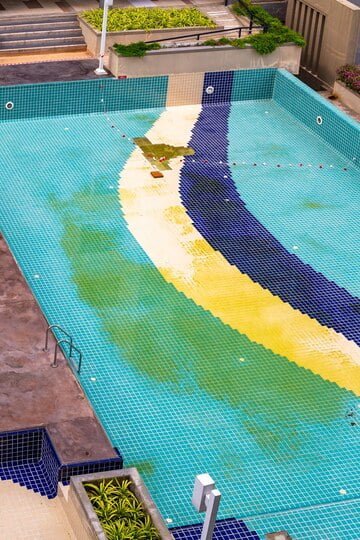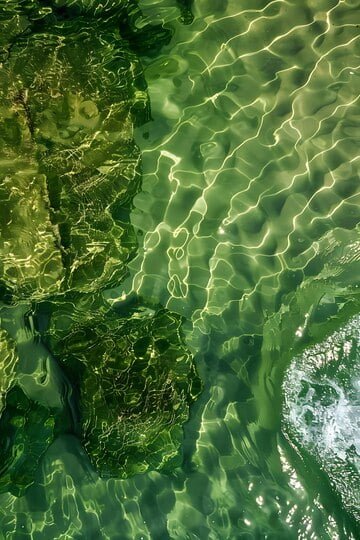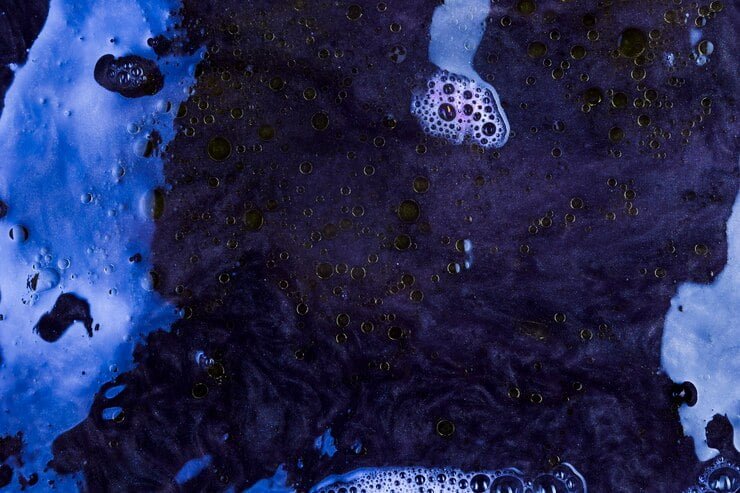Table of Contents
How to Get rid of Black algae in your Pool
Black algae in pools is a persistent and troublesome problem that requires effective treatment to restore your pool’s cleanliness and safety. Known for its resistance to standard pool chemicals and its tendency to cling tightly to surfaces, black algae can quickly turn your sparkling pool into a murky mess. This guide provides actionable steps to effectively eliminate black algae and prevent its return.
Black Algae in pools

1. Identify Black Algae
Before treating your pool, ensure that the algae you’re dealing with is indeed black algae. Black algae is characterized by its dark green to black color, slimy texture, and the presence of small black dots or spores on its surface. It often attaches firmly to pool surfaces, including plaster, grout, and tiles.
2. Brush the Affected Areas
Use a stiff-bristled pool brush to scrub the affected areas thoroughly. This helps to dislodge the algae from the pool surfaces. Focus on areas where algae are visible, such as walls, floors, and pool steps. Brushing also helps to expose the algae to chemicals more effectively.
3. Shock the Pool
Shocking the pool involves adding a high dose of chlorine or a pool shock product to the water. This step is crucial for killing the algae and breaking down its cells. Use a shock treatment designed for black algae, as it is more potent. Follow the manufacturer’s instructions for dosage and application. Typically, shocking is done in the evening to prevent the chlorine from being dissipated by sunlight.
4. Apply Algaecide
After shocking the pool, use an algaecide specifically formulated for black algae. These algaecides contain strong chemicals that target black algae and inhibit its growth. Add the algaecide according to the label instructions, ensuring even distribution throughout the pool.
5. Run the Pool Filter
To remove dead algae and other debris from the water, run your pool filter continuously for at least 24 to 48 hours. Make sure the filter is clean and functioning efficiently. Consider using a pool vacuum to manually remove any remaining debris from the pool floor.
6. Maintain Proper Pool Chemistry
Maintaining balanced pool chemistry is essential to prevent the recurrence of black algae. Regularly test and adjust the pool’s pH, alkalinity, and chlorine levels. Aim to keep the pH between 7.4 and 7.6 and the chlorine levels at an appropriate range based on your pool size and usage.
7. Prevent Future Algae Growth
To prevent black algae from returning, ensure your pool is properly maintained. This includes regular brushing, proper filtration, and consistent chemical treatments. Keep your pool covered when not in use to reduce exposure to debris and potential algae spores.
8. Seek Professional Help
If the black algae problem persists despite your efforts, consider consulting a pool professional. They can provide advanced treatments and assess whether there are underlying issues with your pool’s infrastructure that may be contributing to the algae growth.
By following these steps, you can effectively eliminate black algae from your pool and maintain a clean, inviting swimming environment. Regular maintenance and prompt action are key to keeping your pool algae-free and enjoyable for all users.

What is Algae?
Algae are simple, autotrophic organisms that primarily live in aquatic environments, though they can also be found in damp terrestrial areas. They play a crucial role in the ecosystem as primary producers, forming the base of the food chain by converting sunlight into energy through photosynthesis. Algae vary greatly in size, structure, and habitat.
Types of Algae
- Microalgae: These are microscopic algae that are often found in both freshwater and marine environments. Examples include phytoplankton and certain types of green algae. Microalgae can form harmful algal blooms in conditions of excess nutrients.
- Macroalgae: These are larger algae that are visible to the naked eye. They include:
- Green Algae: Found in freshwater and marine environments, they are often seen as green mats or filaments.
- Brown Algae: Common in marine environments, brown algae include kelp and can form extensive underwater forests.
- Red Algae: Predominantly marine, red algae are known for their reddish color due to pigments like phycoerythrin.
Characteristics of Algae
- Photosynthesis: Algae contain chlorophyll and other pigments that allow them to perform photosynthesis, producing oxygen and organic compounds from carbon dioxide and sunlight.
- Habitat: They thrive in a variety of environments, from oceans and rivers to ponds and even damp soils.
- Reproduction: Algae can reproduce both sexually and asexually. Some algae reproduce rapidly under favorable conditions, leading to algal blooms.
Importance of Algae
- Ecological Role: Algae are essential for aquatic ecosystems as they produce oxygen and serve as a primary food source for many aquatic organisms.
- Economic Uses: Algae are used in various industries, including food (e.g., sushi seaweed), agriculture (e.g., fertilizer), and pharmaceuticals (e.g., dietary supplements).
- Environmental Indicators: The presence and health of algae can indicate water quality and the overall health of an aquatic environment.
Algae in Pools
In pool environments, algae can become a nuisance, leading to unsightly green or black stains and potentially causing slippery surfaces. Regular pool maintenance and appropriate chemical treatments are essential to prevent and control algae growth.
How to Keep Black Algae From Coming Back: Essential Prevention Tips
Preventing black algae from reappearing in your pool requires a proactive approach to maintenance and management. Black algae, known for its resilience and tendency to cling to pool surfaces, can be challenging to deal with once established. Here are key strategies to ensure black algae does not return:
1. Maintain Balanced Pool Chemistry
Consistent pool chemistry is crucial for preventing black algae growth. Regularly test and adjust the following parameters:
- pH Levels: Keep the pH between 7.4 and 7.6 to create an environment less conducive to algae growth.
- Chlorine Levels: Maintain appropriate chlorine levels based on your pool size and usage. Ideally, free chlorine levels should be between 1-3 ppm.
- Alkalinity and Calcium Hardness: Ensure these levels are within the recommended ranges to avoid scaling and other issues that can provide a foothold for algae.
2. Regularly Clean and Brush the Pool
Routine cleaning and brushing help remove potential algae spores and prevent buildup:
- Brush: Use a stiff-bristled brush to scrub pool walls, floors, and steps weekly. This action removes algae and prevents it from establishing a foothold.
- Vacuum: Regularly vacuum the pool floor to remove debris and dead algae that can contribute to new algae growth.
3. Ensure Proper Filtration
A well-functioning filtration system is essential for removing algae and other debris:
Run the Filter: Operate the pool filter for at least 8-12 hours daily, especially during peak swimming season, to ensure proper circulation and filtration.
- Clean the Filter: Regularly clean or backwash the filter to maintain its efficiency and prevent clogging.
4. Use an Algaecide Regularly
Prevention is key when it comes to controlling black algae:
- Algaecide Application: Use a high-quality algaecide designed to target black algae as part of your regular maintenance routine. Follow the manufacturer’s recommendations for dosage and frequency.
- Seasonal Treatments: Consider applying algaecide at the beginning of each swimming season to prevent algae growth before it starts.
5. Address Pool Equipment and Surfaces
Check and maintain pool equipment and surfaces to prevent algae from taking hold:
Inspect Equipment: Regularly inspect pool equipment such as skimmers, pumps, and heaters for signs of algae growth and clean them as needed.
Maintain Surfaces: Repair any damage to pool surfaces that could provide a breeding ground for algae. Cracks and crevices should be sealed to prevent algae from finding a home.
6. Control Water Levels
Proper water management helps deter algae growth:
- Avoid Overfilling: Ensure the water level is not too high, which can cause skimmers to be less effective at removing debris and algae.
- Monitor Water Balance: Regularly check and adjust the water balance to prevent algae-friendly conditions.
7. Reduce Organic Debris
Organic debris can contribute to algae growth by providing nutrients:
- Skim Regularly: Use a net to remove leaves, branches, and other debris from the water surface daily.
- Clean Surrounding Area: Keep the pool area free of organic matter that can fall into the pool and contribute to algae growth.
8. Use a Pool Cover
When the pool is not in use, a cover can be an effective deterrent:
- Cover the Pool: Use a pool cover to reduce exposure to debris and sunlight, which can contribute to algae growth.
- Maintain the Cover: Regularly clean and inspect the cover to ensure it is functioning properly.
By implementing these preventive measures, you can effectively reduce the risk of black algae returning to your pool. Consistent maintenance and vigilance are key to ensuring a clean, algae-free swimming environment.
Home Remedies for Removing and Preventing Black Algae in Your Pool
Dealing with black algae in your pool can be challenging, but several home remedies can help manage and prevent its growth. While these methods may not replace professional treatments for severe infestations, they can be effective for maintenance and minor issues. Here are some practical home remedies to keep black algae at bay:
1. Baking Soda
How It Works: Baking soda is a natural, non-toxic substance that can help increase the pH level and alkalinity of your pool water, making it less conducive to algae growth.
Application:
- Adjust pH and Alkalinity: Sprinkle baking soda directly into the pool water to raise the pH and alkalinity levels. Use about 1.5 pounds of baking soda per 10,000 gallons of water.
- Brushing: For areas with visible black algae, mix baking soda with water to form a paste. Apply the paste to the affected areas and scrub with a stiff brush.
2. White Vinegar
How It Works: White vinegar is a mild acid that can help kill algae and prevent its growth by lowering the pH of the pool water.
Application:
- Direct Application: Mix equal parts of white vinegar and water in a spray bottle. Apply the solution to the areas with black algae and let it sit for about 15-20 minutes before scrubbing and rinsing.
- Cleaning Equipment: Use white vinegar to clean pool equipment and accessories that may have come into contact with algae.
3. Hydrogen Peroxide
How It Works: Hydrogen peroxide is a powerful oxidizer that can effectively kill algae and bacteria in pool water.
Application:
- Treating the Pool: Add 1-2 quarts of 3% hydrogen peroxide per 10,000 gallons of pool water. This will help kill algae and break down organic matter.
- Brushing: For stubborn algae spots, apply hydrogen peroxide directly to the affected areas, let it sit for a few minutes, and then scrub thoroughly.
4. Borax
How It Works: Borax, a common household product, can help to increase the pool’s pH and kill algae due to its alkaline nature.
Application:
- Increase pH Levels: Dissolve about 1 cup of borax in a bucket of water and pour it into the pool. This can help raise the pH level and create an environment less favorable for algae.
- Spot Treatment: Apply borax directly to the algae-affected areas, scrub, and rinse thoroughly.
5. Salt
How It Works: Salt can act as a natural algaecide when used in moderation, especially if you have a saltwater pool system.
Application:
- Salting the Pool: Add salt to the pool according to the manufacturer’s recommendations for your pool size. This can help improve the effectiveness of the pool’s chlorination system.
- Salt Scrub: Mix salt with water to create a paste and apply it to algae spots. Scrub thoroughly and rinse.
6. Citrus Juice
How It Works: Citrus juice, particularly lemon or lime juice, contains natural acids that can help to kill algae and clean pool surfaces.
Application:
- Direct Application: Squeeze fresh lemon or lime juice onto the black algae spots. Let it sit for 20-30 minutes, then scrub and rinse.
- Add to Pool: For a preventive measure, you can add a few cups of citrus juice to the pool water, which helps maintain a less hospitable environment for algae growth.
7. Regular Pool Maintenance
How It Works: Consistent maintenance practices can help prevent black algae from establishing itself in the first place.
Application:
- Routine Cleaning: Regularly brush, vacuum, and skim the pool to remove debris and algae spores.
- Proper Filtration: Ensure your pool filter is functioning properly and run it for the recommended number of hours each day.
Using these home remedies can help manage and prevent black algae in your pool, but they should be complemented with regular maintenance and proper chemical treatments for the best results.
Frequently Asked Questions (FAQ) About Black Algae in Pools
1. What is black algae, and why is it a problem?
Black algae are a type of algae that appears as dark green or black spots in pools. It is known for its resistance to standard pool chemicals and its ability to cling tightly to pool surfaces, including plaster, grout, and tiles. This makes it challenging to remove and can cause unsightly stains and slippery surfaces.
2. How can I tell if I have black algae in my pool?
Black algae are characterized by their dark color and slimy texture. You may notice small black dots or patches on the pool walls, floors, and steps. It often grows in areas that receive less water circulation and can appear in clusters.
3. How do I remove black algae from my pool?
To remove black algae:
- Brush the affected areas with a stiff-bristled brush.
- Shock the pool with a high dose of chlorine or pool shock treatment.
- Apply a black algae-specific algaecide.
- Run the pool filter continuously for at least 24-48 hours.
- Vacuum the pool to remove debris and dead algae.
4. Can home remedies effectively get rid of black algae?
Home remedies like baking soda, white vinegar, hydrogen peroxide, and borax can help manage and prevent black algae growth. However, for severe infestations, professional treatments and proper chemical treatments are usually more effective.
5. How can I prevent black algae from coming back?
To prevent black algae from returning:
- Maintain balanced pool chemistry: Regularly test and adjust pH, chlorine levels, and alkalinity.
- Regularly clean and brush the pool surfaces.
- Use an algaecide designed for black algae.
- Ensure proper filtration: Run the filter regularly and clean it as needed.
- Address any pool equipment and surface issues promptly.
6. How often should I test my pool water for algae prevention?
You should test your pool water at least once a week for pH, chlorine levels, and alkalinity. Regular testing helps ensure that the water chemistry remains balanced and less conducive to algae growth.
7. Is it necessary to cover my pool to prevent algae?
Using a pool cover when the pool is not in use can help reduce exposure to debris and sunlight, which can contribute to algae growth. It’s a useful preventive measure but should be combined with regular maintenance.
8. What should I do if black algae persists despite my efforts?
If black algae persist, consider consulting a pool professional. They can provide advanced treatments, diagnose underlying issues, and ensure that your pool is properly maintained.
9. Can black algae affect the health of swimmers?
While black algae itself is not typically harmful to swimmers, the presence of algae can create slippery surfaces and reduce water quality. Ensuring the pool is clean and properly maintained helps provide a safe swimming environment.
10. How long does it take to get rid of black algae?
The time required to eliminate black algae depends on the severity of the infestation and the effectiveness of your treatment methods. Generally, it can take several days to a week to fully remove black algae and restore your pool to a clean, algae-free state.
By addressing these common questions, you can better understand how to manage and prevent black algae in your pool, ensuring a clean and enjoyable swimming environment.
Conclusion
Effectively managing and preventing black algae in your pool requires a combination of consistent maintenance, proper chemical management, and timely interventions. Black algae, known for its resilience and tendency to cling to pool surfaces, can be a challenging issue for pool owners. However, by understanding its nature and implementing a thorough approach, you can effectively control and prevent its growth.
Key Points to Remember:
- Regular Maintenance: Consistently brushing, cleaning, and vacuuming your pool helps remove potential algae spores and prevents buildup. Proper filtration and water circulation are essential to maintaining a healthy pool environment.
- Balanced Chemistry: Regularly test and adjust your pool’s pH, chlorine levels, and alkalinity to create conditions that are less conducive to algae growth.
- Preventive Measures: Using algaecides, applying home remedies when appropriate, and addressing any issues with pool equipment or surfaces are crucial in keeping black algae at bay.
- Immediate Action: If black algae does appear, act swiftly by brushing the affected areas, shocking the pool, and using specific algaecides to remove it. Continue to monitor and maintain your pool to ensure it remains algae-free.
By adopting these practices, you can maintain a clean, clear, and safe swimming pool environment. Regular attention to pool maintenance and chemistry will significantly reduce the likelihood of black algae reoccurrence, ensuring a more enjoyable and trouble-free swimming experience.
Read more about your Pool


Your article helped me a lot, is there any more related content? Thanks!